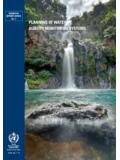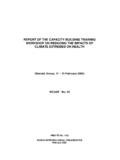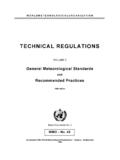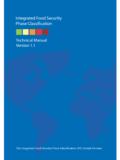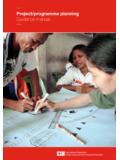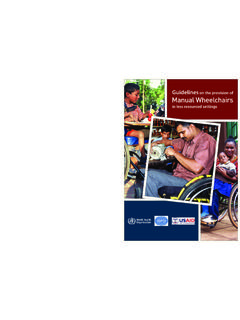Transcription of Guide to the Global Observing System - …
1 Guide to the Global Observing SystemWMO-No. 488 Third edition2007 2007, World Meteorological Organization, GenevaISBN 92-63-13488-3 NoteThe designations employed and the presentation of material in this publication do not imply the expression of any opinion whatsoever on the part of the Secretariat of the World Meteorological Organization concerning the legal status of any country, territory, city or area, or of its authorities, or concerning the delimitation of its frontiers or boundaries. Supplement for NoTINg SupplemeNTS.
2 PurPose,.scoPe,. Purpose and scope of the Global Observing System .. I Global Observing System requirements .. I Organization and implementation of the Global Observing System .. I . General .. II Assessment and formulation of observational data requirements .. II Data sensitivity tests or Observing System experiments .. II Observing System simulation experiments .. II Theoretical studies and simulations .. II Laboratory assessments .. II System design and analysis activities.
3 II Field site assessments .. II End-user application areas .. II Evaluation of requirements against System capabilities .. II The Rolling Requirements Review process .. II User requirements and Observing System capabilities database .. II User requirements .. II Observing System capabilities .. II The Critical Review .. II Statements of Guidance .. II Network design and national requirements .. II Evolution of the Global Observing System .. II 6 Appendix Extract from user requirements and Observing System capabilities database example of Global numerical weather prediction requirements for some variables.
4 1 Appendix Outcome of the Rolling Requirements Review process: examples .. General .. III 1coNTeNTSPageGUIDE TO THE Global Observing Design of observational networks .. III Planning of networks and stations .. III Management of manned station networks .. III General .. III Organization of the station network management unit .. III Administrative arrangements .. III Station network management unit staff .. III Station network management unit operational tasks .. III Logistics and supplies.
5 III Establishment of a new station .. III Regular inspections .. III Other station network management unit activities .. III Procurement of instruments and equipment .. III Instrument checks and maintenance .. III Coordination .. III Planning and budgeting .. III Network performance monitoring .. III Management of automatic surface land station networks .. III General .. III Administrative arrangements .. III Operational tasks of the automatic station network supervising unit.
6 III Surface synoptic stations .. III Organizational aspects .. III General .. III Land stations .. III Sea stations .. III Automatic stations .. III Observations/measurements .. III General .. III Observations at land stations .. III Observations at sea stations .. III Upper-air stations .. III Organizational aspects .. III Site selection .. III Planning of facilities .. III Organization of the upper-air unit .. III Archiving data and maintenance of records .. III Communications.
7 III Personnel .. III Training .. III Quality standards .. III Observations/measurements .. III General .. III Pilot-balloon observations .. III Radiosonde observations .. III Radiowind observations .. III Rawinsonde III Combined radiosonde and radiowind observations .. III Aerological soundings using automated shipboard or land-based upper-air systems .. III Upper-air systems .. III Observational III Special management considerations .. III General .. III Procurement of instruments and equipment.
8 III Maintenance .. III Budgetary requirements .. III Aircraft meteorological stations .. III General .. III Instrumentation and data processing .. III Site selection .. III Observing and reporting procedures .. III Communications .. III Personnel and training .. III Quality standards .. III Aeronautical meteorological stations .. III General .. III Instrumentation .. III Location of meteorological stations and instruments .. III Observing and reporting III Communications.
9 III Personnel and training .. III Quality standards .. III Research and special-purpose vessel stations .. III Climatological stations .. III Organization .. III Climatological station networks .. III Station classification .. III Reference climatological stations .. III Principal climatological stations .. III Ordinary climatological stations .. III Special-purpose stations .. III Operation of stations .. III Quality standards .. III Archiving .. III Agricultural meteorological III Organization.
10 III Station classification .. III Operation of stations .. III Special III General tasks and purposes of special stations .. III Types of special stations .. III Weather radar stations .. III Radiation stations .. III Atmospherics detection stations .. III Meteorological reconnaissance aircraft stations .. III Meteorological rocket stations .. III Global Atmosphere Watch (GAW) stations .. III Planetary boundary-layer stations .. III Tide-gauge III 77 Appendix Functional specifications for automatic weather stations.




